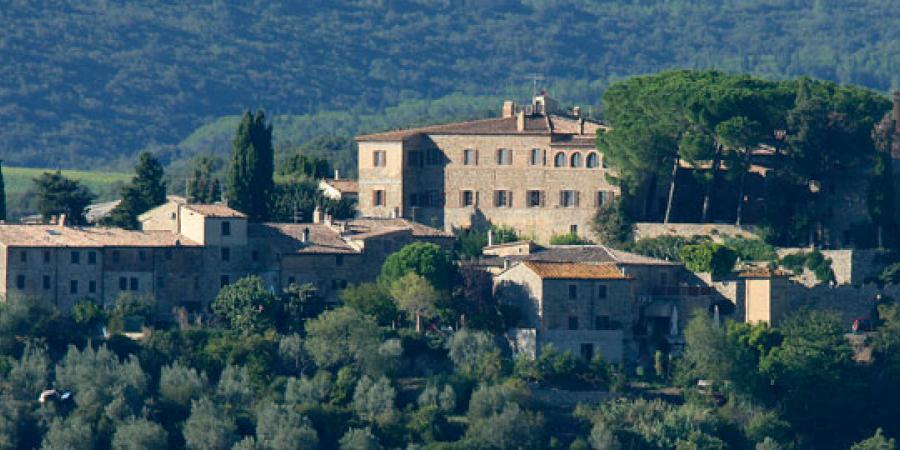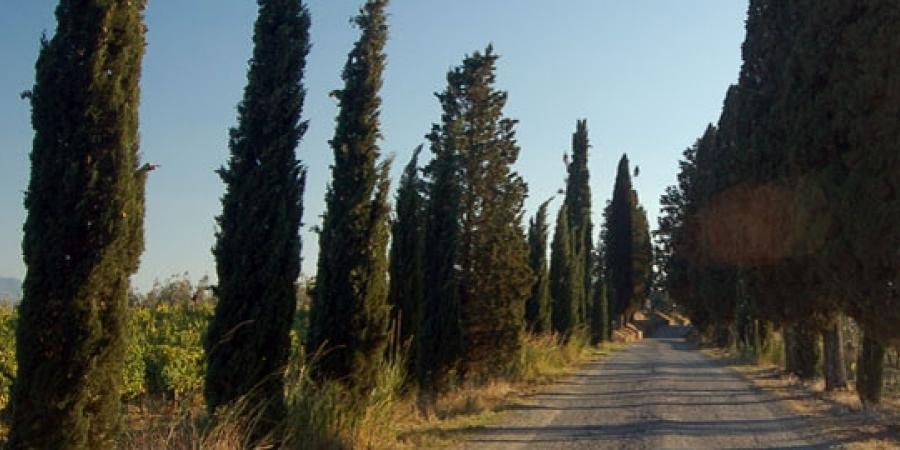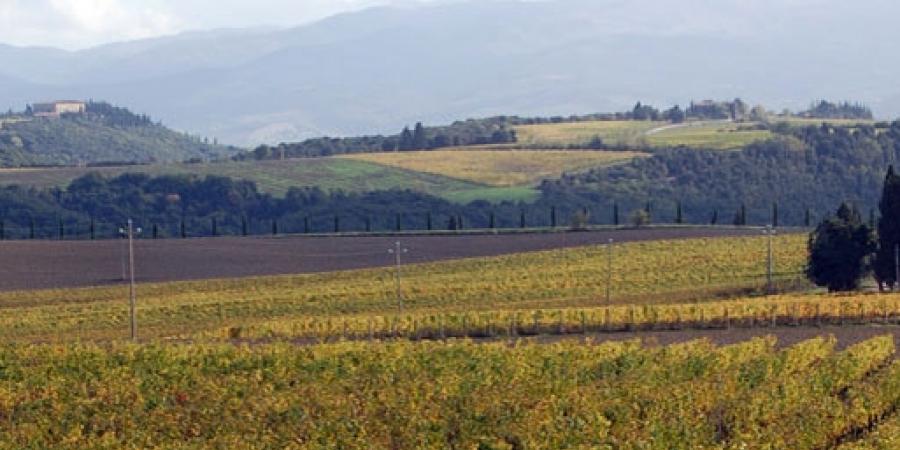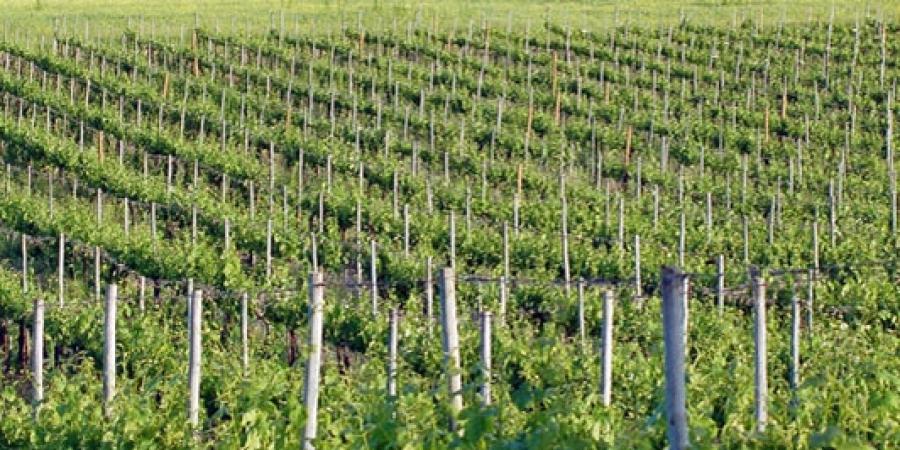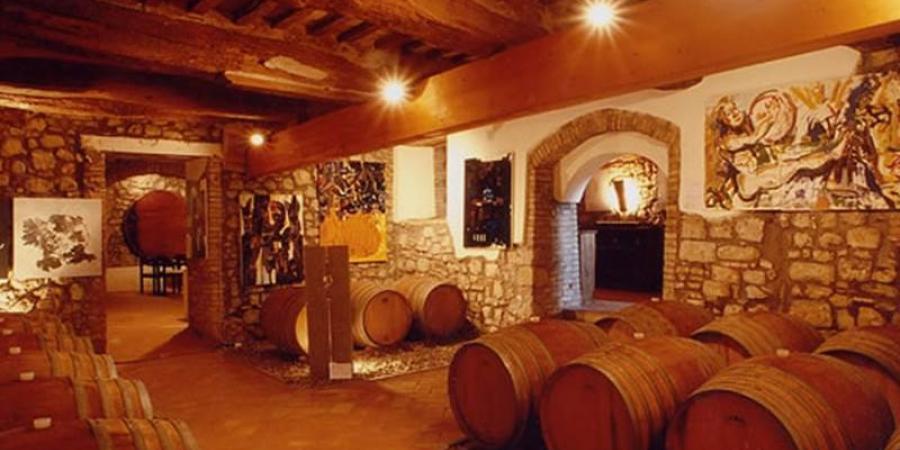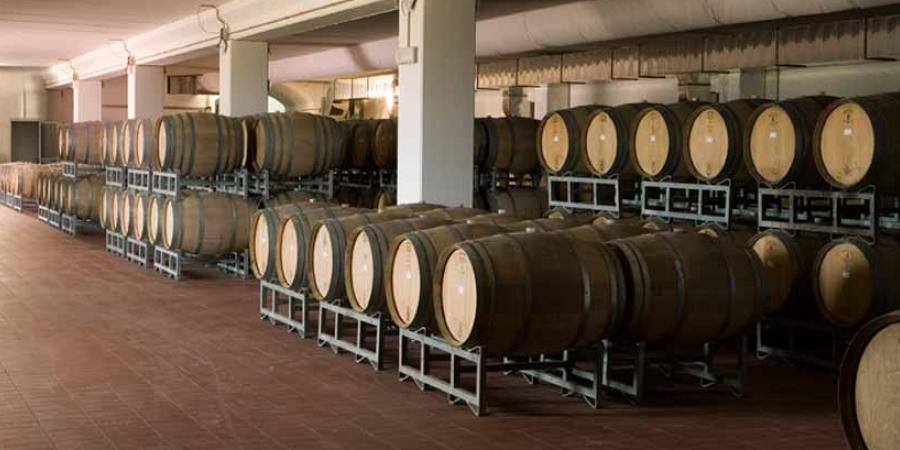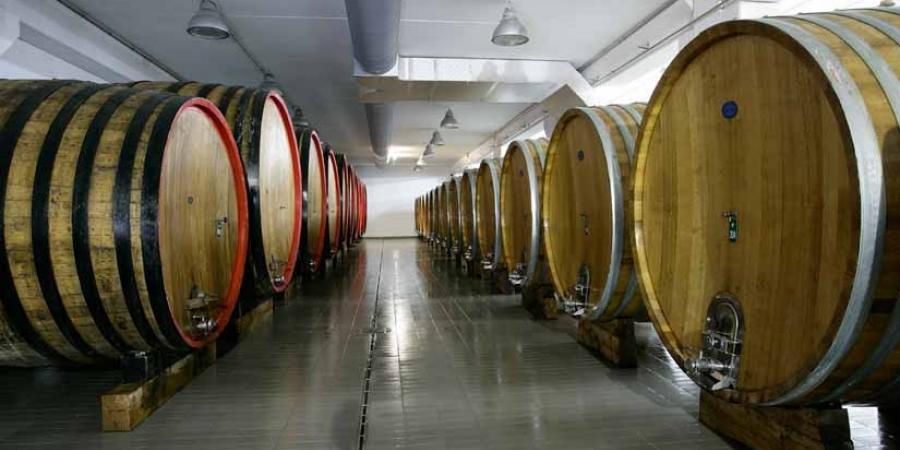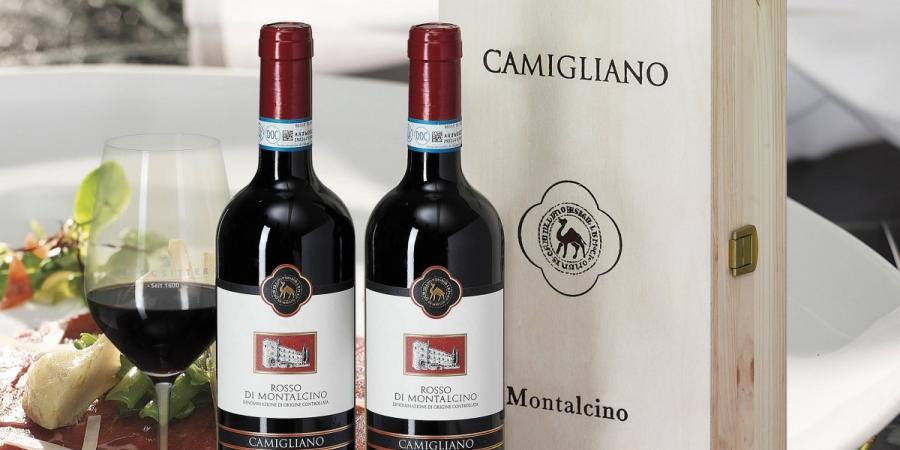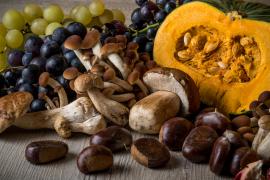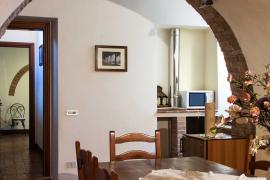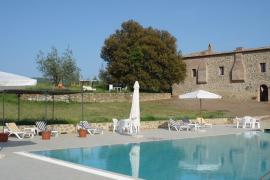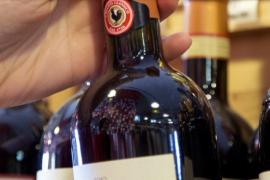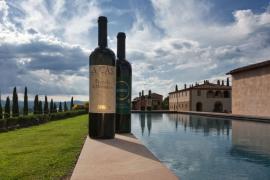The old cellar, located beneath the walls of the old farm, is a perfect place to store vintage wines and for wine tasting. The new cellar is located completely underground in order to preserve the integrity of the landscape and to age the wine properly, in barrels and in bottles.For this purpose, both the temperature and the humidity are maintained at optimum levels (around 14° C – 80% humidity).The work flow has been studied closely to keep the use of pumps to a minimum. Fermentation tanks are equipped for heating and cooling in order to maintain complete control of maceration during and after fermentation. Their special shape makes it possible to regulate the extraction of the beneficial part of the peel, keeping external intervention to a minimum.The wooden barrels in which the wine is aged are kept in spacious areas and are primarily medium to large in size (50-60 hectoliters), the best size for the long aging process required for Brunello.The company has a total of 90 hectares of vineyards, including 50 hectares for the production of BRUNELLO DI MONTALCINO (180,000 bottles) and one for BRUNELLO RISERVA “GUALTO” (around 9,000 bottles).
The following wines are also produced:
ROSSO di MONTALCINO (100,000 bottles);
CABERNET SAUVIGNON St. Antimo “CAMPO AI MORI” (9,000 bottles);
GT TOSCANA “PODERUCCIO” (40,000 bottles);
MOSCADELLO DI MONTALCINO “L’AURA”CHIANTI COLLI SENESI
“BORGONE”tablewine
In addition, the company has an olive orchard and produces TERRE DI SIENA (DOP) Olive Oil (25 hectares) and markets a GRAPPA produced from Brunellopomace. The vineyards are located to the SOUTH of Montalcino, along the gentle hills that slope down to the Maremma, lands rich in tufa and marl. Production, which is lower than the amount required by law, averages 40 quintals (1 quintal = about 220 pounds)/liter/hectare, depending on the age of the vines and whether they are male or female.
Brunello di Montalcino D.O.C.G.
__________________________________________________________________________
THE WINE: The best grapes from the company’s best vineyards are selected to produce Brunello, whose production is maintained at a level well below the limit established by law.
SOIL CHARACTERISTICS: soil with rocky fragments, with a good percentage of silt.
PLANTING DENSITY: 5,000-5,500 plants per hectare.
CULTIVATION METHOD: buttressed string.
VINES: 100 %Brunello di Montalcino (cloned selection of Sangiovese).
WINE MAKING TECHNIQUE: gentle pressing, fermentation in stainless steel at a controlled temperature of 26-28° C, managed with moderate repassing; peel is steeped for 15-20 days, with post-fermentation steeping at 28-30° C.
REFINING TECHNIQUE: 24 months in 25- to 60-quintal oak barrels. An additional two years of aging take place in stainless steel and in bottles.
AGING POTENTIAL: This is a wine that is best at the moment it is released. Aging in the bottle, however, intensifies the delicacy of the tannin and develops the aroma.
CONCLUSION: A great wine with an intense bouquet and balanced tannins that express all the characteristics of the "terroir" in terms of its quality and type, both in the selection of clones and in the selection of the best-situated and sunniest terrain.
A high-class wine that evolves in interesting ways over time. It is recommended for important events – to honor a loved one or a special guest
Brunello di Montalcino GUALTO Riserva D.O.C.G.
____________________________________________________________________________
THE WINE: Made from carefully selected grapes, harvested in vineyards with the best exposure, aimed at obtaining a Brunello di Montalcino of incomparable refinement and sophistication.
SOIL CHARACTERISTICS: sandy soil with shells, marl and a good amount of limestone.
PLANTING DENSITY: 5,000 plants/hectare.
CULTIVATION METHOD: buttressed string.
WINE MAKING TECHNIQUE: gentle pressing, fermentation in stainless steel at a controlled temperature of 26-28° C, managed with moderate repassings; peel steeped for 15-20 days with post-fermentation steeping at 28-30° C.
REFINING TECHNIQUE: 36 months in 25- to 60-quintal oak barrels. An additional two years of aging takes place in bottles.
AGING POTENTIAL: “Gualto” is a wine with excellent aging potential because of the high quality of the raw materials selected in the field. Even after being stored for many years, the wine maintains its original elegance, along with the aromatic development that characterizes great wines.
CONCLUSION: The great substance and refined sensory experience of the wine, the result of the careful selection of the clones, the choice of terrain, and pruning before and during the harvest, make it age well over a long period of time. It would be interesting to open a bottle, after many years, with trepidation and a spirit of discovery, to enjoy a magical experience.
Rosso di Montalcino D.O.C.
____________________________________________________
THE WINE: with paramount refinement in both aroma and taste, it succeeds in expressing the full bouquet of fruit and flowers that characterizes young Sangiovese wines.
SOIL CHARACTERISTICS: Rosso di Montalcino starts with the company's Sangiovese grapes cultivated in the sandy clay soil, with shells, marl and high limestone content.
PLANTING DENSITY: 3,500 plants/hectare for old vines, 5,000 plants/hectare for young vines.
CULTIVATION METHOD: buttressed string.
VINES: 100% Sangiovese.
WINE MAKING TECHNIQUE: gentle pressing, fermentation in stainless steel at a controlled temperature of 25-26° C; peel steeped for 8-10 days.
REFINING TECHNIQUE: Six months in oak barrels, six months in bottles.
AGING POTENTIAL: given the sensory properties of the product, this wine expresses all its characteristics within a year after it is introduced on the market and can age in the bottle for a number of years.
CONCLUSION: A wine that immediately expresses all the great potential of the Sangiovese grape, even after a year of aging. The wine ages over time in interesting ways, even in the bottle. This is a wine for every day, particularly for relaxing in the evening at home, after a day's work
Cabernet Sauvignon Sant'Antimo "Campo ai Mori" D.O.C.
________________________________________________________
THE WINE: from the best fruit harvested from the sandy clay vineyards near the town, which, because of the microclimate of Camigliano, produces a rich, aromatic, full-bodied wine, but one that is elegant and lingers on the palate.
SOIL CHARACTERISTICS: sandy clay soil with a good amount of limestone.
PLANTING DENSITY: 5,000 plants/hectare.
CULTIVATION METHOD: buttressed string.
VINES: 100 percent Cabernet Sauvignon.
WINE MAKING TECHNIQUE: gentle pressing, fermentation in stainless steel at a controlled temperature of 28-30° C, managed with reparsing’s and delestages; peel is steeped for 21-25 days with post-fermentation steeping at 28-30° C.
AGING TECHNIQUE: one year in French oak barrels, followed by 12 months of aging in the bottle.
AGING POTENTIAL: A very long-lasting wine with an excellent phenolic balance, it expresses its full sensory potential some years after harvest and production.
CONCLUSION: A pure Cabernet from the territory of Montalcino is not an anomaly but a confirmation of the wealth of nutrients in the soil, which gives the wine its superior characteristics.
The name comes from the mulberry trees (from the Latin “morus”) that were cultivated in the lands adjacent to the town of Camigliano. The purity of this Cabernet Sauvignon derives from the extraordinary characteristics of the soil, which gives the wine its fresh and fruity bouquet - a balanced combination of aromas that elicits, in an instant, a pleasant feeling of surprise and, immediately afterward, a positive response to its persistence on the palate. This wine is recommended for suppers with friends in a warm, cheerful and intimate atmosphere (Saturday evening)
Poderuccio I.G.T.
_______________________________________________________________________
THE WINE: A full-bodied wine, but at the same time one with delicacy and balance. Brief aging in French oak barrels enhances the grapes, leaving the bouquet of the fruit clearly in evidence.
SOIL CHARACTERISTICS: sandy clay with shells, and Pliocene marl.
PLANTING DENSITY: 5,000 plants/hectare.
CULTIVATION METHOD: buttressed string.
VINES: Sangiovese, Cabernet Sauvignon, Merlot.
WINE MAKING TECHNIQUE: gentle pressing, fermentation in stainless steel at a controlled temperature of 25-26° C, with peel steeped 10-12 days.
REFINING TECHNIQUE: Poderuccio is aged 30 percent in French oak barrels for six months. After refining, it rests for at least four months in bottles.
AGING POTENTIAL: the wine reaches aromatic and taste balance 1-2 years after refining.
CONCLUSION: A wine with an intense fruity bouquet, the result of a fortuitous coupling of Sangiovese, Merlot and Cabernet. It is not a simple IGT, but a sophisticated product, born in sandy clay soil rich in limestone, which, in this part of Tuscany, gives wine its best qualities and creates a wine with a fruity bouquet and delicate persistence on the palate.
The wine is best in the evening, with friends, in the cheerful, casual atmosphere of a wine bar
Moscadello di Montalcino DOC "L'Aura"
_________________________________________________________________________
THE WINE: produced from vineyards planted with Moscadello in an area whose unique microclimate encourages the growth of the “noble rot.” Production is extremely limited, and varies between 5 and 12 hectoliters/hectare.
SOIL CHARACTERISTICS: Lime, with a high percentage of clay.
PLANTING DENSITY: 5,000 plants per hectare.
CULTIVATION METHOD: buttressed string.
VINES: 100 percent Moscadello.
WINE MAKING TECHNIQUE: the grapes are harvested in stages to ensure that the only clusters (or portions of clusters) that are picked are those that have the most flavor thanks to the sun and botritys. They are then pressed, fermented in barrels and stirred.
REFINING TECHNIQUE: About seven months in barrels, six months in the bottle.
AGING POTENTIAL: the wine expresses its sensory characteristics within a year of being placed on the market and improves in the bottle over a number of years.
CONCLUSION: Extremely intense, complex and lively, it has a different mood than the usual great Montalcino "terroir."
As early as 1400, Francesco Redi, of the AccademiadellaCrusca, in “Bacco in Toscana (Bacchus in Tuscany)” thought very highly of this wine, «...of the lovely, the divine Moscadelletto of Montalcino...» Today its production comes from grapes harvested one cluster at a time - infused with the “noble rot.” The wine is aged in the cellar in French oak casks for several months to produce that hint of bitterness that makes it similar to some sauternes. This wine should be sipped slowly at the end of a meal, with a dessert of pasta dura, or even spooned over custard.
Chianti Colli Senesi
________________________________________________
THE WINE: This wine begins in the company's youngest vineyard, where the fruitiness and freshness of the Tuscan Sangiovese grapes are enhanced.
SOIL CHARACTERISTICS: tuffaceous soil, which causes the grapes to mature and yield clusters of ripe grapes that are rich in flavor, with a fruity bouquet.
PLANTING DENSITY: 5,000 plants per hectare.
CULTIVATION METHOD: buttressed string.
VINES: 100 percent Sangiovese.
WINE MAKING TECHNIQUE: gentle pressing, fermentation in stainless steel at a controlled temperature of 25-26° C, managed with repassing; steeping of the peel for 8-12 days.
REFINING TECHNIQUE: the wine rests in large bottles and in steel until it is bottled. It is then further refined for several weeks before going to market.
AGING POTENTIAL: the wine's characteristics are best expressed for up to two years after the vintage
Borgone
________________________________________________
THE WINE: suitable for any occasion - young, lively and light - from grapes harvested around the town of Camigliano during the month of September.
SOIL CHARACTERISTICS: tuffaceous soil, which gives the ripening grapes their fruity aroma and taste.
CULTIVATION METHOD: buttressed string.
VINES: Sangiovese 70-80 percent, Merlot 20-30 percent, depending on the vintage.
WINE MAKING TECHNIQUE: gentle pressing, fermentation in steel at a controlled temperature of 26-28° C, managed with repassing. Peel is steeped 7-10 days.
REFINING TECHNIQUE: the wine is refined in steel with periodic decanting until it is bottled. It does not continue to age once it has been bottled.
AGING POTENTIAL: this is a young wine, and it should be consumed within a year of the vintage
Grappa di Brunello
______________________________________________________________________
A brandy distilled from the pomace of Brunello di Montalcino fresh fermentation in small copper vats and then aged for several months in French Oak barrels of 225 liters in order to get that amber color, aroma, soft fruits and persistent flavor that make it unique and inimitable
Grappa di Brunello Ambrata
______________________________________________________________________
A brandy distilled from the pomace of Brunello di Montalcino fresh fermentation in small copper vats and then aged for several months in French Oak barrels of 225 liters in order to get that amber color, aroma, soft fruits and persistent flavor that make it unique and inimitable
Vermentino I.G.T. "Gamal"
________________________________________________
THE WINE: comes from the vineyard where the micro mediterranean warm and ventilate climate allow vermentino grapes to arise.
SOIL: sandy marly with fossils
PLANTING DENSITY: 5000 p/ha
TRAINING SYSTEM: cordon-trained and spur-pruned
VINE VARIETY:Vermentino 100%
VINIFICATION TECHNIQUES: light pressing, racking, fermentation in stainless steel vats tanks at controlled temperature of 16-18 ° C for 2-3 weeks
AGEING TECHNIQUES: batonnage of 4-5 months at a controlled temperature of 16 ° C and then in the bottle.
CONCLUSION: a fresh,aromatic wine, best with fish, nice for snacks, drinks and in 'happy hour” or drink with friends in wine bars.
Olio extra vergine di oliva D.OP. Terre di Siena
________________________________________________
THE OIL: Terre di Siena Olive Oil was one of the first Italian D.O.P. designations awarded for olive oil – the mark of the area’s unquestionable dedication to quality.
THE TERROIR: the superb terroir combines with our work methods: harvesting by hand and pressing at a controlled temperature immediately after the harvest. The result is an extra virgin olive oil with the typical characteristics of the best Sienese oils.
CULTIVARS: leccino, frantoio, moraiolo, correggiolo.
CULTIVATION METHOD: polyconic vase pruning.
CONCLUSION: The oldest trees recall our common Mediterranean roots, our history and many literary references, but above all they are strikingly beautiful, with the silver filigree of their leaves shining in the sun.
